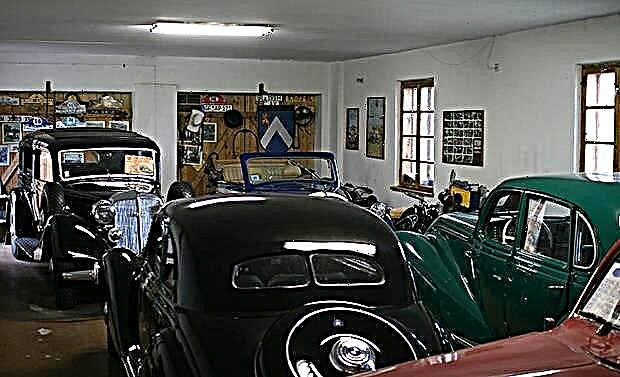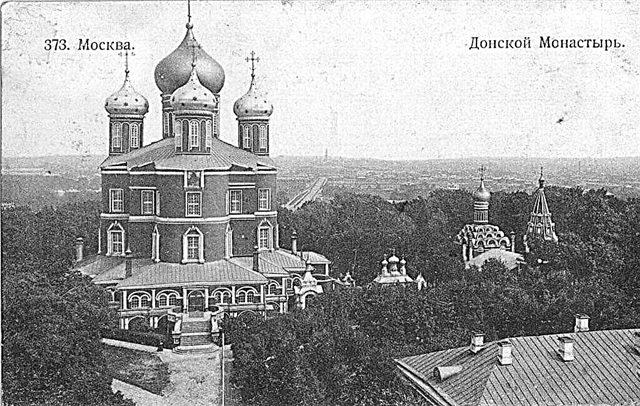The Donskoy Monastery is the home of the Donskoy Icon of the Mother of God. There is peace and quiet in the house - a powerful, high fence, an apple orchard, larch trees, linden alleys help to keep the silence, which is not much in Moscow.
History
2017 - the history of the monastery is 426 years old. It was originally associated with the Donskoy Icon of the Mother of God - the shrine was in the camp of Russian archers, preparing for a battle with the Mongol-Tatar troops. The battle did not take place, because shortly before the start of the battle, for not entirely clear reasons, Khan Kazy-Girey left the battlefield. Then it was considered that such, one might say, an amazing outcome occurred due to the intercession of the Most Holy Theotokos and on the site of the tent in which the icon was kept they built a cathedral (later they began to call it Small Donskoy).

Then another Don Cathedral was built nearby (it began to be called the Bolshoi), the log fence was replaced by brickwork, in which the walls were replaced by towers (twelve in total), a bell tower with the Church of Zechariah and Elizabeth was added, cells, family tombs, a chapel, chambers, a theological seminary , archimandrite chambers, churches of Alexander Climacus, Archangel Michael, Alexander Nevsky, Alexander Svirsky, George the Victorious, John Chrysostom, Tikhon, Tikhvin church.
The monastery had not only good, but also bad days:
- 1771 - the tragic Plague Riot
- 1812 - ruined by the French
- Soviet times - churches turned into state institutions, camps and towers - into living quarters, a crematorium was launched
The bad was replaced by the good only in the 1990s - a revival began. Today it is a monastery for men.
Necropolis - "old" and "new", a memorial to white soldiers
There are two cemeteries on the territory of the Donskoy Monastery: the old one (called the monastery necropolis) and the new one. Each of them has its own story.

The monastic necropolis is the last chambers for Russian noblemen (Dolgoruky, Menshikov, Trubetskoy, Potemkin, Golitsyns), wealthy merchants (here is the unusual grave of Saltychikha - the wealthy landowner Daria Saltykova), many famous artists, poets, generals, composers, philosophers, historians, writers , architect Osip Bove, Russian scientist, creator of aerodynamic science Nikolai Zhukovsky. This place is called the most aristocratic place of eternal rest in Moscow. It so happened that during the reign of Catherine II, due to the plague epidemic, a decree appeared prohibiting burial in the city limits - exceptions were made to high-ranking persons and big money.
A separate story is at the memorial to the white soldiers (located on the territory of the necropolis) - the comfortable burial place of the leaders of the "white movement" generals Denikin and Kappel, as well as the Russian philosopher Ilyin (their remains were brought to Moscow for reburial in 2005-2006). Russian Prime Minister Vladimir Putin proposed to equip the gravestones in 2009, which was realized with his help and for his personal funds. At the "new" cemetery, which appeared at the end of the 19th century, scouts, singer Maya Kristalinskaya, actress Faina Ranevskaya are buried. Here, in mass graves, are buried the executed prisons of Lefortovo and the basement of the Lubyanka, the soldiers of the Second World War who died in Moscow hospitals.
Architectural tomb
The Donskoy Monastery is not only the resting place of our ancestors, but also an architectural burial vault. In 1934, a museum was created here, to which fragments of ancient monuments destroyed by the Soviet government were brought. Among the remains of the lost architecture are episodes of the temples of St. Nicholas and the Assumption, high reliefs from the Cathedral of Christ the Savior, the Triumphal Gates of the Belorussian (now Brest) station (they were brought disassembled, and 30 years later they were re-installed on Kutuzovsky Prospekt), parts of the Sukharev tower.
There is one more attraction - the remains of a tank column formed during the Great Patriotic War. With the help of the believers' charitable funds, it was possible to purchase 40 combat vehicles. They were merged into a division named after Dmitry Donskoy. The restored cars were installed at the main entrance.
Shrines
It so happened that the Don icons - the most important shrines - are two. One is the one mentioned above (which was in the streltsy camp). Before the battle, known to us as the Battle of Kulikovo, it was given by the Cossacks to Prince Dmitry of Moscow. Now this icon "lives" in the Tretyakov Gallery (formerly in the Kremlin) and is annually brought to the monastery on its holiday (September 1). The second was written to order (at the request of Boris Godunov), it does not leave the walls of the monastery.

In the Donskoy Monastery (in its Small Cathedral) it will turn out to see the only operating world-making furnace in the possession of the Russian Orthodox Church. It is launched every three to four years during Great Lent to prepare the holy peace. A special aromatic oil used in the sacrament of chrismation and consecration of thrones is prepared in large quantities - for all monastic parishes. Here they began to cook it after the revolution of 1917 (initially myrrh was prepared in the Cross Chamber of the Patriarchal Palace of the Moscow Kremlin (the old cruciform, marble-faced miro-making stove is still kept in it)).

A very important shrine is the relics of the Patriarch of All-Russia Saint Tikhon. The last years of his life he spent in the confinement of the monastery walls in custody. The relics were found by accident during the restoration of the Small Cathedral from the consequences of a fire that broke out in the refectory. Patriarch Tikhon was canonized and canonized in 1989, that is, even before the discovery of the relics (they were found in 1992).
Among the main spiritual shrines:
- miraculous icons of the Mother of God "Feodorovskaya" and "Sign"
- letters from Simon Ushakov miraculously preserved during the fire and decorated with a special shade (list of the Don image of the Most Holy Theotokos)
- icon of St. Nicholas (kept in the chapel-burial vault of Levchenko)
- burial place of Yakov Polozov (cell attendant of Patriarch Tikhon), who in 1924 saved his life by going out to meet the murderers and taking three bullets. Yakov was buried at the southern wall of the Small Don Cathedral at the insistence of the saint.
Where is it located and how to get there
The exact address is Donskaya Square, 1 - 3 (the main entrance is located on the side of this street). The nearest metro station is Shabolovskaya. It is possible to contact the pilgrimage center at the Donskoy Monastery by phone 952-02-63.











